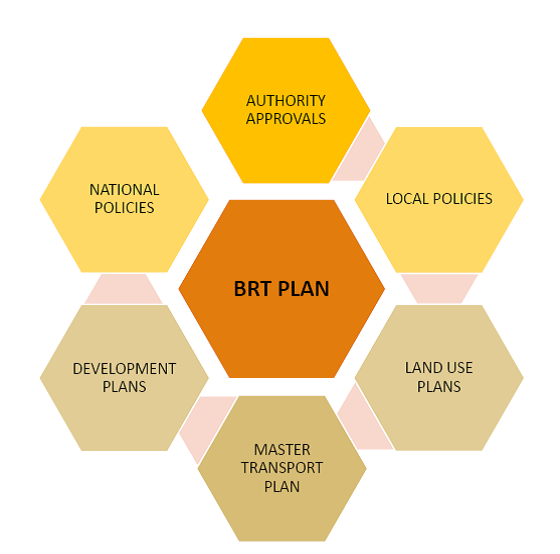3.2Legal Basis
When men are pure, laws are useless; when men are corrupt, laws are broken.Benjamin Disraeli, British politician, 1804–1881
3.2.1Statutory Approval
In most examples, a statutory or legal mandate is required before the BRT project gains recognition or acceptance. Statutory approval signals the potential for the allocation of public funding to the project, thereby also allowing the employment of dedicated staff to work on the project. The actual authorization process will vary depending on the local, provincial, and national legislation and delegations. Despite the efforts of a political champion or support group, several steps may still be required to formalize the project. It is only once this legal authorization is in place that the actual forming of a project team, the development of a work plan, the drafting of a project budget, and the full financing of the BRT planning project can commence.
Maintaining an open and transparent process throughout is fundamental to the success of the project. If the project is not implemented in an entirely legitimate and pluralistic manner, long-term public and political support can be undermined. If the proper statutory authorization processes are not followed, opponents of the project could find easy ways to stop the project. The proper legal mandate will also serve to establish the BRT project as a citywide priority across all levels of administration.
Beyond an initial mandate to begin the planning process, other approvals or authorizations may also be required. These authorizations may include the establishment of a special BRT unit or the transformation of an existing agency, the approval of the project budget or loans, and the adaptation or promulgation of legislation and policies regarding the funding, implementation, and operation of the BRT. As most of these approvals may require formal political and administrative processes, this phase of the project could take considerable time and effort. It is best to identify these formal requirements at the outset of the planning process. Although it is advised to make use of existing legal frameworks rather than depending on radical changes to facilitate the project, some projects may require the establishment of an adequate legal framework to structure the BRT implementation.
3.2.2Context within Existing Legislation and Policies
The vision of the new public transport system should be in accordance with the intent and objectives of existing legislation and policies. A lack of consistency in this regard will provide detractors of the system the opportunity to legally delay or block the initiative. It is therefore possible that the BRT concept may require some amendments or additions to existing legislation and policies before it can be fully endorsed and implemented.

While BRT itself may not be explicitly noted in an existing transport master plan, stated objectives to improve public transport are most likely present. Drawing a connection between the new vision and the master plan is worthwhile to ensure overall integration of the new system with the existing direction of the city’s transport plan. If improved public transport is not a stated objective within the master plan, or if BRT will somehow contradict existing objectives, then a review of the master plan may be in order.
Likewise, economic development, environmental authorizations, and land use plans should be examined for consistency with the proposed initiative. Typically, the reduction in congestion associated with a new public transport system will directly connect economic objectives to the BRT project. Existing land use plans should reference transit-oriented development (TOD) and/or the densification of residential and commercial sites along key corridors. Such references would be consistent with the objectives of a BRT initiative. Land use and environmental policies should be adapted to incorporate the concept of mass public transit. This must occur as an early priority in the project to minimize later delays for approval processes.
Making use of international or donor funding may require the need to amend local financial legislation or policies to allow for the incorporation of this funding in existing budget structures, or, in some cases, the protection of this funding by setting up alternative budget-management structures to protect the funding from being used for purposes other than the planning of a BRT system.